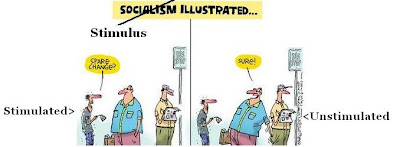Some selected excerpts from the Time Magazine Cover Story "Why We're So Gloomy":"I haven't really been able to sort out exactly why there has been this degree of pessimism."
~Former President BushWell, why are Americans so gloomy, fearful and even panicked about the current economic slump?
In one of history's most painful paradoxes, U.S. consumers seem suddenly disillusioned with the American Dream of rising prosperity even as capitalism and democracy have consigned the Soviet Union to history's trash heap. Hard times are forcing some people to turn their back on the American Dream.
"Whining" hardly captures the extent of the gloom Americans feel as the current downturn enters its 14th month. The slump is the longest, if not the deepest, since the Great Depression. Traumatized by layoffs that have cost more than 1.2 million jobs during the slump, U.S. consumers have fallen into their deepest funk in years.
While some economists have described the current slump as a near depression, that phrase overstates the case if it is taken as a comparison with the period 1929-33, when the U.S. economy contracted by nearly a third. The D word becomes more valid, especially with a small d, when it is used to compare the growth rate of the 1930s, which averaged 0.5% a year, with the expected sluggishness of the next decade, which some economists predict will see an average growth rate of 2%.
"I'm worried if my kids can earn a decent living and buy a house," says Tony Lentini, vice president of public affairs for Mitchell Energy in Houston. "I wonder if this will be the first generation that didn't do better than their parents. There's a genuine feeling that the country has gotten way off track, and neither political party has any answers. Americans don't see any solutions."
The deeper tremors emanate from the kind of change that occurs only once every few decades. America is going through a historic transition from a heedless borrow-and-spend society to one that stresses savings and investment. When this recession is over, America will not simply go back to business as usual.
The underlying change in the way American consumers and business leaders think about saving and spending will make the recovery one of the slowest in history and the next decade one of lowered expectations. Many economists agree that the U.S. will face at least several years of very modest growth as consumers and companies work off the vast debt they assumed in the last decade.
The conditions that led to today's transition economy go back several decades. Americans have suffered a long-term stagnation of their earnings. The median income of U.S. families has virtually stood still since 1973, showing an annual gain of just 0.3% a year.
The recent debt binge took place on a colossal scale in every sector of the economy. Runaway federal deficits have more than tripled the national debt. Meanwhile, consumers increased their IOUs from $1.4 trillion to $3.7 trillion last year. And U.S. industry raised its debt from $1.4 trillion to $3.5 trillion over the same period. The reckless borrowing made a reckoning inevitable.
So far, though, no reprieve from layoffs is anywhere in sight. Economists say U.S. companies will shed more than 1 million jobs in fields ranging from banking to aerospace, a pace even faster than last year's. "It's become almost like a poker game to see who can cut the most," says employment analyst Lacey. "There's a kind of corporate frenzy."
GM's plans to close 25 plants and cut 74,000 jobs, or 19% of its work force, scarcely addresses such problems as why it takes the company up to a year longer than the Japanese to redesign its cars.
MP: This was from the January 13, 1992 edition of Time Magazine, and the opening quote was from President George H.W. Bush, and the article was about the relatively mild 1990-1991 recession. Note: I altered some of the text above so that the specific time period was not obvious. Notice the distinct similarities to the reporting about today's economy.
HT: Alex Tabarrok at Marginal RevolutionUpdate: The 1990-91 recession started in July of 1990 and ended in March of 1991, but the end of the recession wasn't announced by the NBER until December 1992, so the Time Magazine article was actually written ten months after the 1990-1991 recession ended.




































